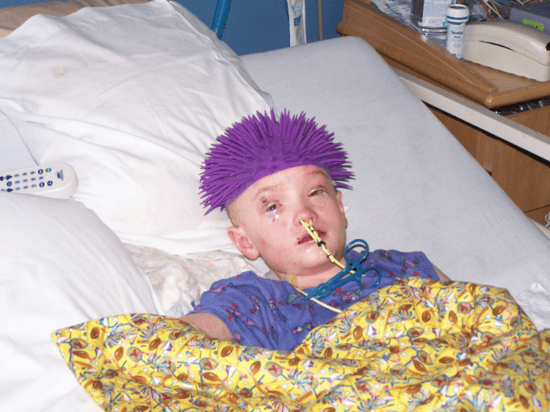While some of his grade school classmates looked up to famous athletes or television characters, Will Osier’s childhood superhero was his ophthalmologist. Now, more than 15 years later, Osier is set to attend the University of Colorado School of Medicine where his doctor pioneered a treatment that saved his vision.
Osier was 8 years old when he woke up one morning with a head-to-toe rash. The pain in his eyes and mouth was accompanied by a 106-degree temperature. The diagnosis was Stevens-Johnson syndrome (SJS).
SJS is a rare but potentially devastating disorder, affecting five to 10 people per million each year. It is most commonly an adverse reaction to medication and causes painful skin blisters all over the body, including the surface of the eyes and backs of the eyelids, as Osier experienced. These blisters can lead to a buildup of scar tissue that causes debilitating, chronic eye pain and vision loss.
“A lot of my memories from the early days are just pictures of me in the hospital. I was so sick and couldn’t see, so it was hard to conceptualize how sick I was,” Osier recalls. “I remember the first time I saw myself in the mirror when I was in the hospital. I didn’t recognize myself. I had lost a lot of weight and my head was shaved so they could do skin grafts.”
The treatment he received 10 days into his illness not only prevented severe vision problems for Osier, but it became the most widely accepted and effective procedure for preventing the potentially blinding, scarring problems in SJS patients worldwide.
Creating the standard
To rescue Osier’s vision, Darren Gregory, MD, associate professor of ophthalmology at the Sue Anschutz-Rodgers Eye Center, performed a treatment, called a cryopreserved amniotic membrane transplantation (AMT), that had only been done a few times prior to help prevent scar tissue from developing and causing irreversible damage to the eyes.
Osier was the fourth person — and second child — in North America to receive the treatment.
“It’s sort of like Saran wrap,” Gregory says, explaining the thin membrane used in the transplant. “It has potent anti-inflammatory and anti-scarring effects. It allows tissues that are injured, particularly when there is a burn or the skin has been scraped off, to heal with normal tissue rather than scar tissue.”

Will Osier, then 8 years old, received a cryopreserved amniotic membrane transplantation (AMT) that ultimately saved his vision. Photo courtesy of Will Osier.
The treatment can be powerful for the back surface of the eyelids, which consist of smooth, moist mucosal tissue. If scar tissue develops on this part of the lids, it can feel like sandpaper on the eye and blinking can be debilitating and painful, potentially leading to blindness.
“Will was a pivotal case because, along with the case before him, it demonstrated to us that we needed to try this treatment sooner on SJS patients,” Gregory says.
In the handful of cases that followed Osier, it became apparent to Gregory that ophthalmologists needed to be involved in the patient intake process to act fast enough to get the best results.
“We started doing the procedure earlier on patients and after I’d done about five or six cases, I had some questions about the membranes, so I called the company that processes and distributes them in North America. I talked to the medical director, who said, ‘I think you’ve done this more than anybody in the world. You should publish research on this and tell people about it,” Gregory recalls. “So, that’s what I’ve been doing for the past 15 years.”
Since Osier’s treatment, Gregory has published grading criteria on how to evaluate SJS patients and determine when to perform the transplant. In SJS, the sooner the treatment is done, the better the results tend to be, so Gregory and his team typically operate within a day or two of the patient’s admittance to the hospital. The treatment can also be used for other health issues where scar tissue might develop around the eyelids.
“We also use the treatment in patients who have had strong acids or chemicals splash in their eye to try and minimize the scar tissue that forms. There are lots of settings where we’re able to use this membrane as a bandage to decrease scar tissue formation,” Gregory says. “We're attempting to suppress the body's reaction to an injury to minimize the scarring because, unfortunately, our bodies don't really care if we can see or if our eyes are comfortable. It just heals them with whatever is expedient.”
The use of amniotic membrane to treat the eyes in acute SJS is increasing throughout North America, South America, Europe and especially in India, where SJS cases are more common and severe. The evolution of the treatment continues, and Gregory consults with surgeons throughout the world as they treat this challenging disease, helping to prevent painful, blinding complications in thousands of patients.
Following a hero’s footsteps
The treatment allowed Osier to live a mostly normal life. He’s had more than a dozen eye surgeries related to SJS to correct problems such as eyelashes rubbing on his eyes, but he says he feels fortunate.
“I'm just glad I showed up when I did. Dr. Gregory saved my vision and allowed me to have an outcome that I couldn’t have had otherwise,” Osier says.
Osier graduated with a biochemistry degree from Colorado College in 2020 and now works as a clinical assistant at Children’s Hospital Colorado, where he says Gregory’s care has inspired his own work and future in medicine.
“Medicine is such a cool career, but I think for me it was having a hero in medicine,” says Osier. “I had a lot of follow-up appointments, and I would look forward to them. Dr. Gregory would ask me questions about soccer and my life that made me feel special as a kid.”
That’s something Osier says he tries to emulate in his health care positions now.
“It highlighted the power a really amazing physician can have on a patient’s life,” he says.
Osier will start as a medical student this year and anticipates graduating in 2027.
“I hope he finds a field of medicine that he's enthused about, whether it's ophthalmology or a different field,” Gregory says. “And that he does his best to find something where he can help people and be excited about the work.”

.png)
.png)

